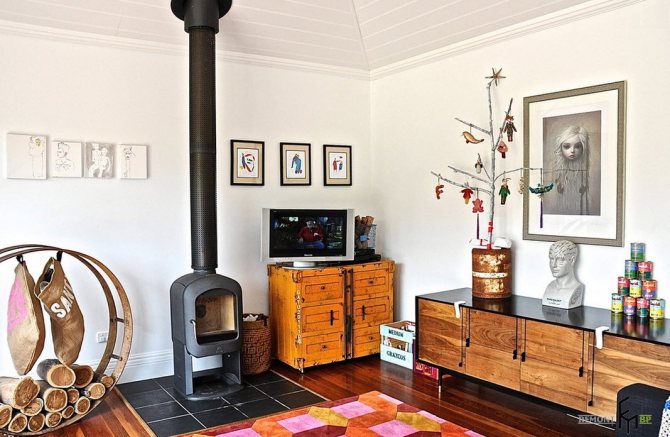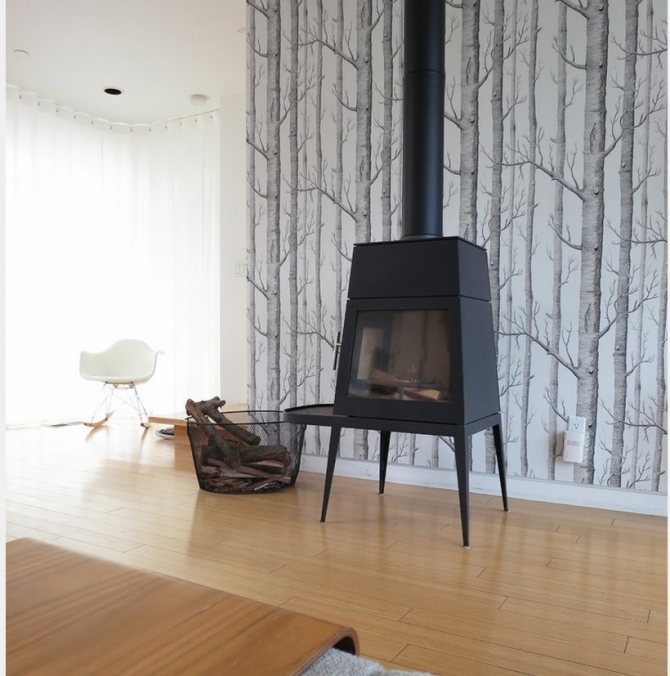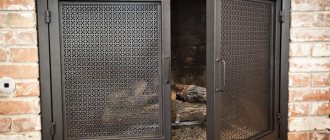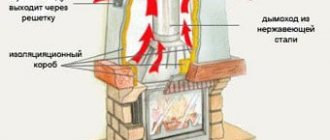Owners of wood-burning fireplaces, undoubtedly, are faced with the question of choosing the most suitable firewood for operating the fireplace, so that heating the room is more efficient and fuel consumption is as economical as possible. You can read the guide on how to choose wood-burning fireplaces for your home here.

The picture shows a fireplace with wood.
Which is better?
Naturally, the best firewood for a fireplace should provide more heat when burning, while smoking as little as possible. When choosing a certain type of firewood for a fireplace, one should be guided by a simple rule: the higher the density of the wood, the more heat will be from the firewood.
The most common types of wood used as fuel are:
- Poplar (not the best option for heating a fireplace, you can use it if you don't have other firewood). Poplar is widespread, so the price for this type of firewood is very low. But the quality of wood is very low, poplar firewood burns out very quickly, while not much heat is generated.
- Oak (the highest quality firewood). Oak firewood is characterized by high heat transfer and long burning time. Oak firewood is suitable for both closed and open fireboxes. But oak firewood is notable for its high cost, and not every owner of a wood-burning fireplace can afford to be heated with oak wood.
- Birch (widely used as fuel for wood stoves and fireplaces). Birch firewood gives a good heat, but it is still recommended to use it in fireplaces with a closed hearth, as birch firewood tends to generate a lot of smoke.
- Of conifers, pine and larch are widely used as fuel for fireplaces. Pine and larch firewood burns beautifully, while giving off a lot of heat.
- Aspen and alder, according to the density of wood, belong to soft wood species, and are used only as firewood, for cleaning the chimney from soot.
Keep in mind that raw wood with 50% moisture will burn less efficiently than dried wood with 15% to 20% moisture. Read a review of manufacturers of electric fireplaces.


The picture shows a heating fireplace with masonry of firewood for it.
The firewood combustion temperature is influenced by the design features and material of the furnace, as well as the intensity of oxygen entering the furnace. For example, firewood burning in a stone or brick stove or fireplace occurs more evenly and for a long time than in a metal stove-stove.
The combustion temperature of poplar wood is 468 ° C, while the heat output of the wood is 39% out of 100%.
The burning temperature of oak wood is 840 - 900 ° C, while the heat output of the wood is 70 - 75% of 100%.
The burning temperature of birch firewood is 816 ° C, while the heat output of firewood is 68% out of 100%.
The burning temperature of pine wood is 624 ° C, while the heat output of the wood is 52% out of 100%.
The burning temperature of alder wood is 552 ° C (aspen wood 612 ° C), while the heat output of alder wood is 46% (aspen wood 51%) out of 100%.
The length of firewood for the fireplace is selected based on the size of the combustion chamber. The most optimal size of firewood will be their length, equal to 2/3 of the furnace hole. The most common length of logs is 33 cm.
What is the best wood for the fireplace?
Not all fireplace wood can provide effective heat, beautiful flames, and safety. You need to know the characteristics of wood species in order not to be mistaken with the choice.An important indicator is the specific heat of combustion. After all, burning the same amount of logs, you can get a completely different amount of heat.
Hardwood - the best option, it practically does not form smoke and emits a lot of heat. When burning, firewood for a softwood fireplace produces less heat and in order to ensure a consistently high temperature in the room, it needs to be burned much more.
If you do not yet know how to properly heat a fireplace with wood, you should not stop your choice on coniferous wood, as it may be unsafe. Yes, pine and spruce logs give off a lot of heat when burned, but at the same time they smoke a lot and clog up chimney ducts and fireplace glass with soot. Another feature conifers is a high resin content, which causes a lot of splash of sparks
and a pleasant crackle. If the fireplace does not have doors, then such firewood can carry a certain danger, because the fire shoots far away with its orange arrows and this can provoke a fire.
Elite firewood
Elite firewood for the fireplace is the highest quality firewood. The material for elite firewood is carefully selected, the firewood is washed, packaged, dried to a certain percentage of humidity (18%), in addition, elite firewood can be soaked in essential oils. Elite wood is cleaned of foreign particles and does not leave dirt on the floor. Elite firewood, as a rule, is supplied with an individual stamp of the manufacturing company. An overview of the characteristics and types of built-in electric fireplaces here: https://mykaminz.ru/kaminy/vidy-kaminov/elektricheskie/obzor-xarakteristik-i-vidov-vstraivaemyx-kaminov-elektricheskix.html.
Firewood for open construction
When choosing how to heat an open fireplace, you need to take into account that the smell of burning material enters the room. Therefore, tree species with a high resin content in the composition are not suitable. But you can add a little pine needles for a pleasant aroma.
Alder firewood is considered to be of good quality. It is easy to identify the belonging by the orange color of the wood. In tsarist times, alder was used to quickly warm up the bathhouse. High heat transfer, pleasant smell and almost no smoke characterize alder wood.


Birch wood is more common and less expensive. If you peel off the bark, then the emission of smoke during combustion will be negligible. And birch bark can be excellent for kindling a fireplace. If the house is constantly heated with birch, then it is advisable to clean the chimney every month. The exercise provides good traction when firing up.
A pleasant aroma appears in the room when using the wood of fruit trees. To fill the room with a healing scent, the branches of the garden trees left after pruning are used. The raw materials must be thoroughly dried.
Provide beautiful combustion with low heat emission for aspen firewood. It is recommended to heat the fireplace with aspen raw materials several times a season in order to clear the chimney from excess soot.
Artificial
It is not always possible to equip a fireplace that runs on natural wood, for example, in an apartment. And in this case, apartment owners resort to various tricks, for example, install fireplaces that run on electricity or biofuel. And for a better imitation of a real fireplace, the hearth can be additionally equipped with decorative firewood.
Ceramic firewood is made from heat-resistant ceramic. Ceramic firewood qualitatively imitate wood logs. This type of artificial firewood is intended for reusable use in biofireplaces. Ceramic firewood can be used right next to the fire, as it is resistant to high temperatures. Read an overview of the types and photos of fireplaces on this page.
Electric firewood is equipped with LED lighting, simulating the effect of smoldering firewood. This type of firewood is used in fireplaces powered by electricity.


Decorative firewood for fireplaces in the photo.
Closed option
Thinking about what kind of wood is better to heat a fireplace with a glass covering the firebox, it comes to the understanding that the range of suitable options here is much wider. In addition to the types of firewood that we have already considered, you can use other wood that emits smoke, sparks, because the fire is reliably hidden behind a protective screen. The main thing is that the length of the firewood for the fireplace allows them to be fully loaded into the firebox and close it.
When choosing firewood for a closed fireplace, it should be remembered that hard, strong wood burns out more time than soft wood, therefore, additional logs will need to be thrown less often, and heat transfer will be higher.


Closed fireplace in a private house
Warm ash. If we consider dense and strong wood, which can burn even in its raw state, then ash is beyond competition. These woods are considered to be the hottest with maximum heat dissipation. Ash is an excellent option in cases where it is necessary to heat the room in the shortest possible time, quickly heat the bath. Linden has similar characteristics, but it is not possible to find it, like ash, in all regions.
Fragrant needles. As we said earlier, conifers are not suitable for kindling open fireplaces and stoves, but in a closed version they will be appropriate. Coniferous firewood is distinguished by good heat transfer, and the combustion period of wood can be described as normal, and what a pleasant aroma from them. It is optimal to use pine for the house, it has a greater heat transfer.
An obvious disadvantage of needles is its increased resin content, from which soot and soot will inevitably form on the walls of the chimneys. If your firebox is covered by glass, then you will have to clean it after using such wood.
Useless poplar. One of the cheapest firewood is poplar wood. The fact is that these firewood burns very quickly, and they emit very little heat. The relevance of their use in the fireplace is controversial, but in the warm season, if you need a short cozy pastime, such firewood may well be thrown into the fireplace.


Alluring fire in the fireplace
When harvesting wood for your fireplace, do not forget about the size of the logs. Do not make too thick or thin firewood. The optimal size is considered to be a width of 6-8 centimeters, but you choose the length based on the size of the firebox. The normal length of logs is 2/3 of the width of the firebox.
Good to know: How to make DIY fuel briquettes, simple instructions
Regardless of what kind of wood you use in fireplaces and stoves, you should try to dry it as much as possible. In this case, its characteristics will be optimal. For normal drying of the forest, it should be stored by placing it in a well-assembled woodshed with a well-thought-out design.
How to heat?
In order to kindle the fireplace, you will need improvised means (chips, splinters, newspapers), which are laid out in an even layer on the grate. The starting material is ignited. Then firewood is laid in the combustion chamber. The logs are laid horizontally (leave a one centimeter gap between the logs). Further, with the help of a blower, the draft in the fireplace is regulated. Read a review of the characteristics and photos of electric corner fireplaces.
Photo coasters
A stand for firewood for a fireplace is necessary for storing a small supply of firewood near the fireplace; in such a stand, firewood is additionally warmed up and dried for further use.
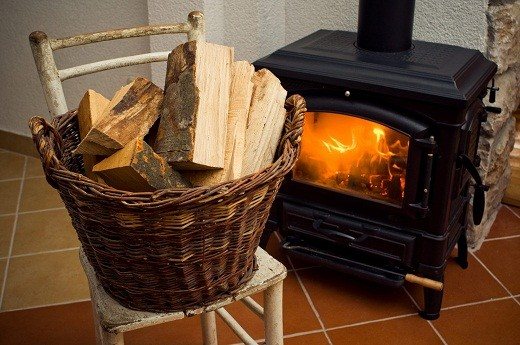

A wicker basket used as a woodpile for storing firewood looks very colorful.


The photo shows a classic forged woodpile.


Wood piles can look very original, for example, as in the photo.
